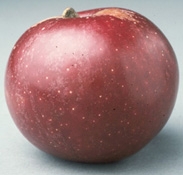
As our nation expanded from sea to sea, homesteaders took apples with them. And eventually some of those settlers ended up in bear-infested Arkansas. The hilly terrain of the Ozark region wasn’t well suited for row crops, or much else for that matter, but it did grow apples well. At one time Benton County was the known as a leading apple producing region and not as Wal-Mart's headquarters.
Arkansas's heyday of apple production has long since passed, but there are a few remnants of the past that are still around Ozarks including a annual festival in Lincoln, whose orchards have since been converted to houses. It may sound surprising but there is a large following of enthusiasts of antique apple varieties, all of which seem to have a backstory. (Well, maybe it's not that surprising. If there are folks that get excited about daylilies, anything could be interesting to someone out there.)
Gardeners interested in heirloom varieties should consider growing ‘Arkansas Black’ apples. This apple was found in a nursery in Benton County around 1870. Most experts in these sorts of things believe that this variety was a chance seedling of ‘Winesap’, another favorite with heirloom aficionados.
‘Arkansas Black’ is named for its famously dark skin color. Other than color the other defining characteristic of this variety is its extreme firmness. At harvest in October, ‘Arkansas Black’ could probably substitute for a baseball. Ozark farmers would raise this apple and then store it in straw-lined pits for months before attempting to eat it. Long storage was definitely a positive attribute in those days, and in January the fruit was soft enough for the dentally challenged to enjoy the flavor of this apple.
My grandfather grew this apple in his front yard in Lake County. He lost his teeth in WWII and couldn't bite this apple with his dentures, so several times he tried to graft it to a softer-fleshed variety. As far as I know, his tree still survives.
Today 'Arkansas Black' has reemerged as a popular hobby variety. While not everyone appreciates an apple that bites back, like fine wines the unique flavor and firmness of ‘Arkansas Black’ mellows with age.
I have this variety in my back yard in West Bishop. It seems to do fine in the Owens Valley, assuming your kids don't do you a favor and harvest your crop in July. As it ripens in October, it probably isn't the most reliable choice at higher altitudes. Last year mine were perfect November 15, but they probably should have been harvested before Halloween.
The widespread planting of apples in this country is testament to the simple demands of the apple tree on the gardener. Like roses, a gardener can make apple growing a complex endeavor with spraying and pruning, or they can elect to let nature run its course and see what happens. Of course the most satisfactory results are usually found in well-tended orchards.
As a rule, apples need to be planted with a pollinator in order to set fruit. Most apple varieties will suit this purpose so if you already have an apple or crabapple, you should get good pollination assuming you do not kill bees with insecticides during the bloom period. If you need to get a pollinizer and can't decide which to use, I would suggest ‘Golden Delicious’. While it is not the most remarkable or unique apple variety, it has a long bloom period and produces a lot of pollen.
Apple trees will grow in all sorts of light levels, but if you want any fruit, you will need to plant them in a place they will continue to get lots of sun. A good rule of thumb for a home orchard would be to space trees as far apart as the canopy will be tall. An apple tree on its own roots can easily get 30 feet tall so this wouldn’t leave a lot of room in most yards.
The solution to finding enough room for an apple tree comes from selecting the correct rootstock. Gardeners can easily find rootstocks that can keep a tree 11 to 18 feet tall and pruning could further influence the ultimate height.
Most garden catalogues sell dwarf plants which are usually on a rootstock called M9, but home gardeners seldom have the option of selecting a specific rootstock. While full dwarfing is a nice convenience, home gardeners would be well-advised to select one of the taller semi-dwarf rootstocks such as M106 or M111 if given the option. They provide better anchorage and drought-tolerance: a real benefit here with our wind and dryness.
There are as many opinions as to the best way to train an apple as there are apple growers, but generally the best results come from a tree shaped like a Christmas tree. Whatever shape you choose the important thing is to be consistent every year. It's hard to go from a vase to a pyramid.
‘Arkansas Black’ is a unique heirloom variety that has a lot to offer the amateur orchardist. Excellent storage, great fresh flavor, and good cooking characteristics make it an apple well-suited for gardens. And it tastes different from what you'd get at the store.